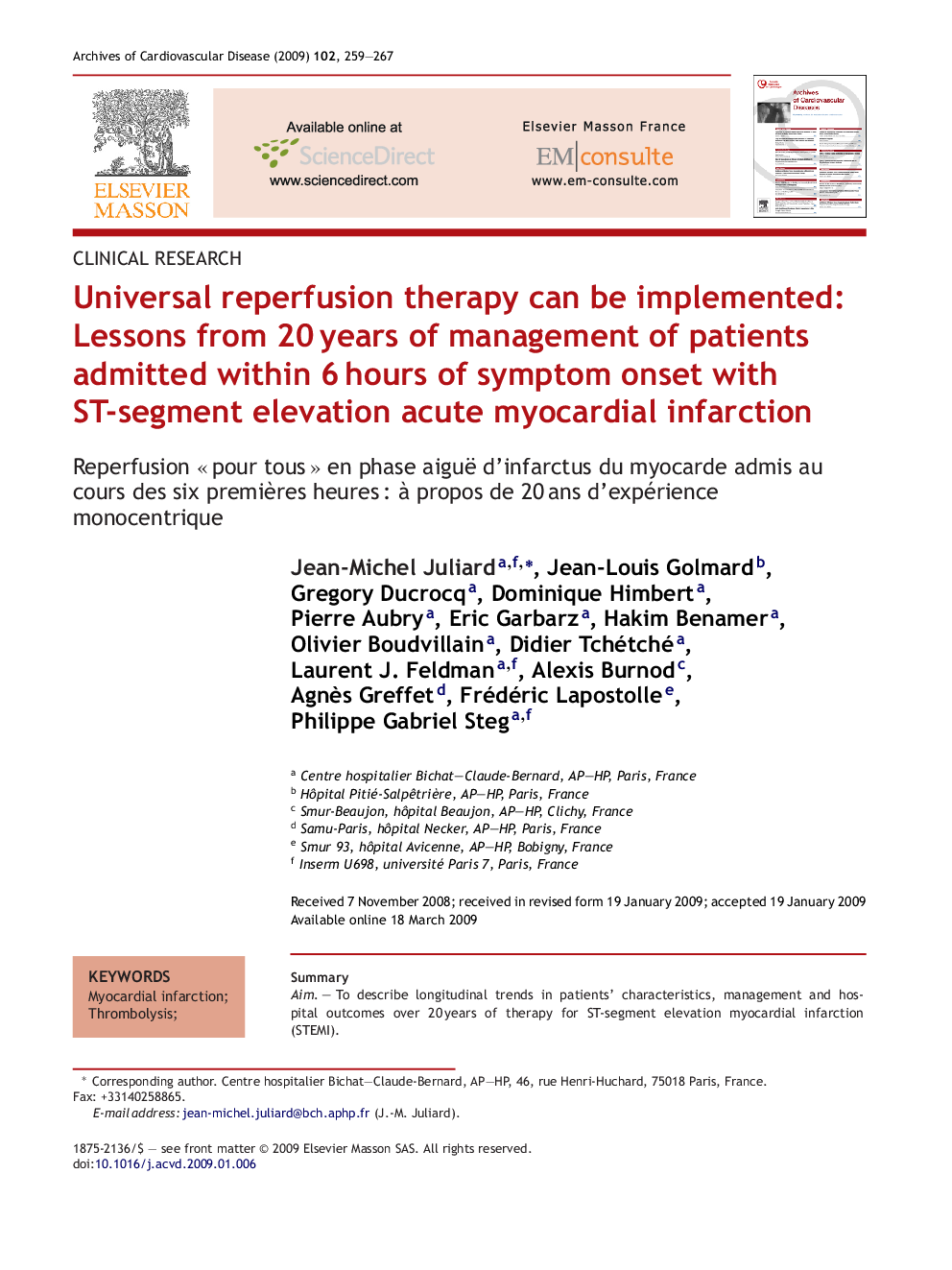| کد مقاله | کد نشریه | سال انتشار | مقاله انگلیسی | نسخه تمام متن |
|---|---|---|---|---|
| 2889098 | 1574404 | 2009 | 9 صفحه PDF | دانلود رایگان |

SummaryAimTo describe longitudinal trends in patients’ characteristics, management and hospital outcomes over 20 years of therapy for ST-segment elevation myocardial infarction (STEMI).MethodsFrom 1988 to 2007, 2100 consecutive patients with STEMI were admitted within 6 hours of symptom onset to a centre with a systematic reperfusion policy. The population was divided into three periods 1988–1996, 1996–2001 and 2001–2007.ResultsThe baseline risk of mortality increased over time (p = 0.02). Use of primary PCI increased and the proportion not receiving reperfusion therapy decreased (from 11.4 to 4.2%, p = 0.0001). Adjunctive use of stents and glycoprotein IIb/IIIa antagonists increased. The proportion of patients achieving acute TIMI-3 flow in the infarct artery increased (81 to 92%, p = 0.001), while time from symptom onset to reperfusion decreased (240 to 205 min, p < 0.0001). This was associated with a decrease in age- and sex-adjusted in-hospital mortality from 8.9 to 7.7% and eventually 5.4% (p < 0.01). However, the mortality of patients with cardiogenic shock was unaffected (76, 62 and 61%, respectively, p = 0.18).ConclusionReperfusion therapy can be implemented in up to 96% of STEMI patients admitted within 6 hours of symptom onset and this is associated with improvements in outcomes. Further improvements are needed in the management of patients with cardiogenic shock.
RésuméObjectifsDécrire l’évolution dans le temps des caractéristiques cliniques des patients, les modifications dans l’usage des techniques de reperfusion et leur impact sur les événements cardiovasculaires majeurs au cours de l’infarctus aigu du myocarde admis au cours des six premières heures.Méthodes et résultatsDe 1988 à 2007, 2100 patients ont été admis consécutivement pour infarctus aigu du myocarde au cours des six premières heures. La population a été scindée en trois périodes : 1988–1996, 1996–2001 et 2001–2007 correspondant chacune à un groupe de 700 patients. Le risque global de chaque cohorte augmente avec le temps (p = 0,02). L’utilisation de l’angioplastie primaire augmente alors que le pourcentage de patients ne recevant pas de traitement de reperfusion diminue avec le temps (de 11,4 à 4,2 %, p = 0,0001). L’utilisation des stents et des inhibiteurs des récepteurs GP IIb/IIIa augmente. Le pourcentage de patients obtenant un flux TIMI 3 en phase aiguë augmente (81 à 92 %, p = 0,001), avec dans le même temps une diminution du temps entre le début de la douleur et la reperfusion effective (240 à 205 minutes, p < 0,0001). La mortalité hospitalière ajustée sur le sexe et l’âge diminue de 8,9 à 7,7 % et finalement 5,4 % pour la dernière période (p < 0,01). Cependant, la mortalité des patients admis en choc cardiogénique est restée inchangée (76, 62 et 61 %, p = 0,18).ConclusionUn traitement de reperfusion a pu être appliqué à 96 % des patients admis au cours de six premières heures d’un infarctus du myocarde, permettant d’obtenir une réduction de la mortalité hospitalière. Au cours du choc cardiogénique, la stratégie idéale de prise en charge reste à définir.
Journal: Archives of Cardiovascular Diseases - Volume 102, Issue 4, April 2009, Pages 259–267